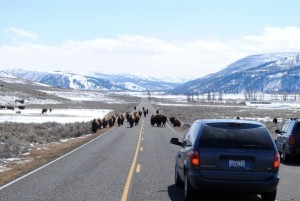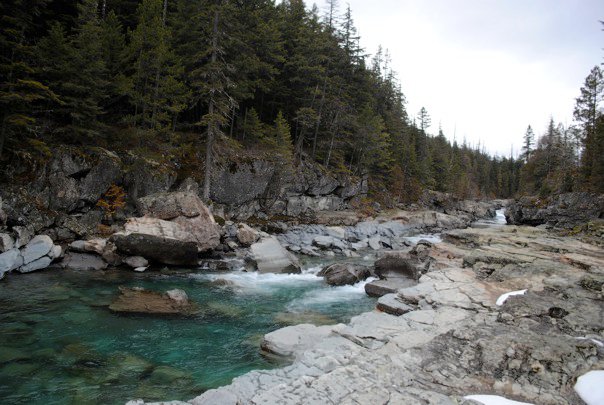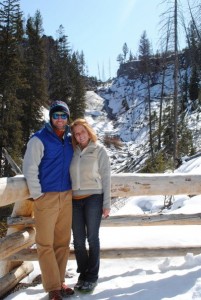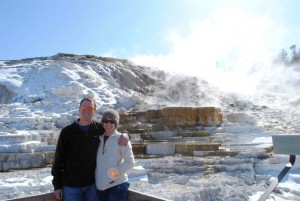
Yellowstone traffic jam. In addition to the ever-present bison, we saw herds of elk and pronghorn, a coyote, and, according to a ranger, the season's first black bear.
It’s a recent and welcome development that I’m able to derive a legitimate enjoyment from things like animals, waterfalls, sunsets, and wildflowers. This progression comes on the heels of a prolonged period where I mostly faked caring about all of it; I could intellectualize the reasons people provided when they talked appreciatively of nature’s simple gifts, and I parroted them appropriately. I just didn’t much find much inspiration in it myself. Nature was basically a peripheral concern – if the approach trail happened to wander through a pristine rhododendron grove on the way to the crag, awesome; if not, you know, whatever. The joy was always in the doing, not the being.
Because of this, I’ve long had a dismissive attitude toward most of our national parks. I considered them to be, on the whole, places where people went when they didn’t really want to do anything; rather, they just wanted to be. They wanted to be near animals, they wanted to be near waterfalls, they wanted to be near sunsets and wildflowers. Because the officials knew this to be the case, they made it pretty easy to visit most of the parks’ major attractions without having to do anything other than drive. If I had a free week to spend somewhere, that’s precisely the opposite of the experience I was after.

The preternatural blue of Glacier's McDonald Creek.
Certainly, there are exceptions – Yosemite, Joshua Tree, Grand Teton, Denali, Grand Canyon, Zion – all of these are places where it’s very easy to do; but, for every one of those, there’s a place like Acadia or the Everglades or the Great Smoky Mountains where being is, as far as I can tell, the dominant activity. Again, I have no trouble understanding these parks’ places among America’s jewels (the Everglades is clearly a unique and remarkable environment, and GSMNP boasts more than ten thousand species of plants and animals), and there’s no doubt that a measure of action-sport elitism is an ingredient here. I recognize that the point of the national park system is not to collect the country’s best climbing and rafting spots, even if it often succeeds in doing so. Still, those are the experiences I was looking for when I went into the wild, and I wanted to do them in places that felt more like parks and less like museums.

Michelle and me in snowy Yellowstone. Only one of the major roads was open, but we had plenty to explore for one day.
Lately, though, I’ve found myself more satisfied with the being, and I attribute that, in large part, to the amount of doing I’ve been, well, doing for the past few years. The majority of days I spend outside are either at the end of a rope or at the back of a raft. The same things that make these activities so fun and attractive for me also guarantee a high-stress experience. Practice and diligence can lessen the stress to an acceptable level, but there’s nothing I can do to get rid of it completely (and I wouldn’t want to even if I could). Over time, though, all that stress takes a toll, and it’s refreshing to grab a light pack and a camera and not have to worry whether or not this will be the day I come home with a broken ankle. I’m not even close to ready to bury my climbing rack for good, but, for the first time, I can imagine a situation where I might be.
Given all that, I was eager to test out this new-found fondness for being when Ben and Rachel, two of my best hometown friends, flew out to help Michelle and me celebrate our last week in Montana. The high points on our agenda (other than the NCAA championship/Braves opening day/Masters trifecta) were trips to Glacier and Yellowstone National Parks – places that I had heretofore placed squarely in the museum category.

Ben and Rachel at Mammoth Hot Springs.
I’m sorry to report that the results of the experiment are, as yet, inconclusive. I had a blast at both parks, but it’s hard to say how much my expanding interests really contributed. There’s a certain population of people that can make most any situation fun for me, and my companions on this particular trip more than qualify. For instance, we walked five miles of closed-off park road in Glacier, only to be diverted by a prohibiting sign a quarter-mile shy of our destination. We walked the same five miles back in the rain and laughed the whole way to the car; no amount of maturity and quiet meditation will bring me to a place where I can enjoy that scene on my own. On the other hand, the young black bear who chose Yellowstone’s Mammoth Hot Springs as the ideal spot to spend a lazy Friday afternoon was thoroughly entertaining and exciting, and I can think of no qualification that might detract from how much I enjoyed watching him play around in such a setting. By contrast, the dominant emotion during my last encounter with a black bear was annoyance at the mother and two cubs whose trail occupancy cut short one of my fall training runs. That seems like progress.

